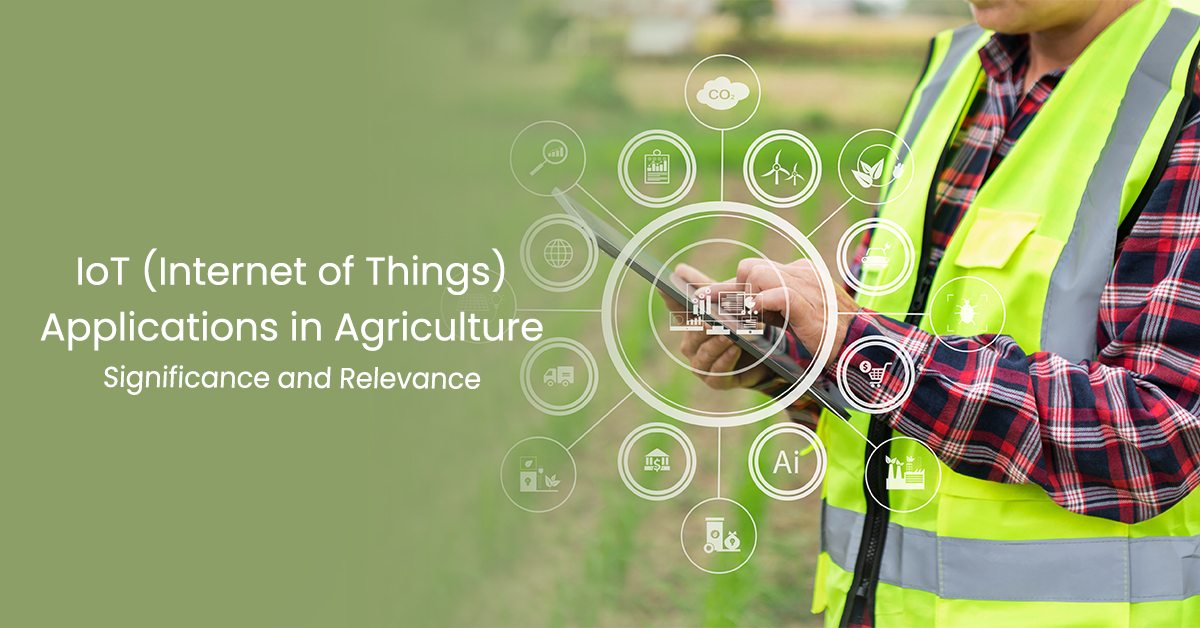IoT (Internet of Things) Applications in Agriculture: Significance and Relevance
Agriculture is still a significant sector in a developing economy like India, contributing approximately 18% of the total GDP and covering around 64% of the entire workforce. Technological advancements are occurring across different sectors, and agriculture is no exception. The real potential of agribusiness can truly be realized with the help of modern technology. In this context, the role of IoT (Internet of Things) technology in farming comes into the picture.
IoT-Internet of Things consists of smart devices that can transfer data over a network. IoT enables farmers to monitor their fields anywhere, anytime, with no hassle. IoT solutions such as robotics, drones, remote sensing, and computer imaging are reshaping agriculture today. IoT in farming helps mitigate the challenges farmers usually face, like climatic conditions, extreme weather conditions etc. The main objective of integrating IoT into agriculture is to increase demand and decrease production losses.
Smart Agriculture using IoT
IoT technology has impacted many industries, from smartwatches to driverless cars. However, agriculture has the most significant impact of all. A recent study suggests that IoT device installation in the agriculture industry will have an annual growth rate of 20%.
Let us discuss the various applications of IoT in agribusiness and know how smart farming IoT is relevant today.
Precision Farming
Precision Farming is one of the most talked about applications of IoT in farming. It comprises smart techniques like irrigation management, vehicle tracking and livestock management that help farmers boost the efficiency of their agricultural practice.
It enables farmers to use data collected with the help of sensors and make data-driven decisions. For example, IoT sensors collect data on soil condition, temperature, lighting, humidity etc., based on which farmers can decide what amount of water, fertilizers, and pesticides crops need for optimal and healthier plant growth. Moreover, farmers can easily monitor all connected devices’ real-time working conditions to monitor water and nutrient level.
Crop Management Devices
Crop management devices are usually placed in the field to acquire information like precipitation, temperature, and overall crop health. Farmers can prevent any diseases affecting the field by monitoring crop health.
Real-Time Weather Conditions
Farming depends heavily on the climate conditions. The lack of knowledge about climate can cause serious concerns about the quantity and quality of crop production. However, IoT solutions provide information about real-time weather conditions through sensors. The IoT ecosystem comprises sensors capable of detecting real-time climatic conditions like temperature, rainfall, and humidity. These sensors gather environmental data to help farmers decide the suitable crops to grow and sustain in specific climatic conditions.
Moreover, these systems send an alert if disturbing weather conditions are suspected. IoT in agriculture eliminates the need for human intervention during disturbing climatic conditions. Thereby helping farmers to boost productivity.
Agricultural Drones
Agricultural drones are coming forth as disruptive technologies. Their role is paramount regarding crop monitoring, field analysis, planting, crop spraying and crop health. For example, the multispectral sensors in the drones identify the areas that require changes in irrigation.
Drones are equipped with more than surveillance capabilities; they can perform menial tasks such as planting crops, agriculture spraying, crop monitoring, etc.
Cattle Monitoring
With IoT agriculture sensors, farmers can track animal health and log performance. Such sensors can be attached to the animals, and the relevant data can be acquired easily. For example, farmers can use these sensors to identify the health conditions of the animals. If there are any sick animals found, farmers can separate them and avoid further contamination in the herd. Some other agriculture sensors also offer nutritional insights into cattle.
Greenhouse Farming
IoT in farming supports greenhouse farming, a farming approach that improves crop yield by monitoring and controlling various environmental factors such as temperature, humidity, pressure etc. Conventionally, human intervention is crucial to managing greenhouses. But it involves spending on labor and energy loss.
IoT in farming eliminates the need for human intervention. It creates a smart greenhouse that monitors and controls the environmental factors needed for crop growth. Moreover, the smart greenhouse can be accessed through a cloud server.
For instance, IoT sensors can access automatic irrigation systems and turn on the lights, among other automated tasks. Thus, smart greenhouses enabled by IoT can enhance crop yield without human intervention.
Conclusion
Agriculture production ensures food security across the globe. The global population is estimated to reach 9.6 billion by 2025. And feeding this vast population is going to be challenging with traditional farming. Thus, considering IoT applications in farming is inevitable.
The IoT paved the way for smart farming, a tech-driven, capital-intensive modern farming technique. This smart approach to farming enables farmers to achieve maximum crop yields with minimum effort and time. However, apart from offering numerous benefits, IoT adoption poses a few challenges, such as high costs and security-related concerns. Nevertheless, IoT solutions can revolutionize agriculture if implemented mindfully, considering the growing demands.

